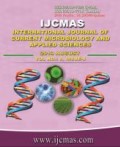


 National Academy of Agricultural Sciences (NAAS)
National Academy of Agricultural Sciences (NAAS)

|
PRINT ISSN : 2319-7692
Online ISSN : 2319-7706 Issues : 12 per year Publisher : Excellent Publishers Email : editorijcmas@gmail.com / submit@ijcmas.com Editor-in-chief: Dr.M.Prakash Index Copernicus ICV 2018: 95.39 NAAS RATING 2020: 5.38 |
Hydrodynamic cavitation is a technology for the conservation of soil and water and waste water treatment due to its simple reactor design and capacity in largeâ€Âscale operation. When fluid’s local pressure reaches a level lower than the saturation vapour’s pressure at environment temperature, cavitation bubbles begin to grow and together with fluid flow are driven to the points with high pressure where they are quickly collapsed. The potential of hydrodynamic cavitation as an advanced oxidation process (AOP) for wastewater treatment, showing its suitability and efficiency against a wide variety of contaminants and concentrations, with very low operation costs, simple equipments and no reactants required. In the review paper related to hydrodynamic cavitation and its techniques for the soil and water conservation and use of associated processes in water and effluent treatment technologies will be discussed.
 |
 |
 |
 |
 |